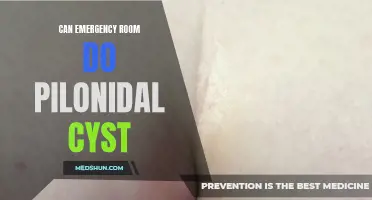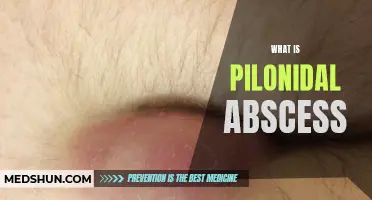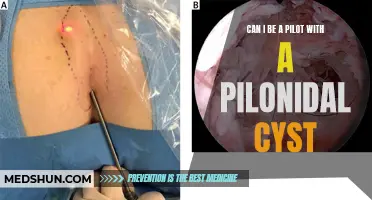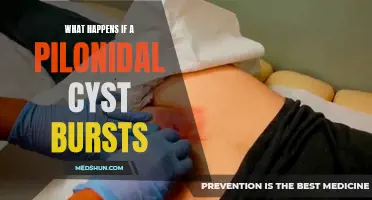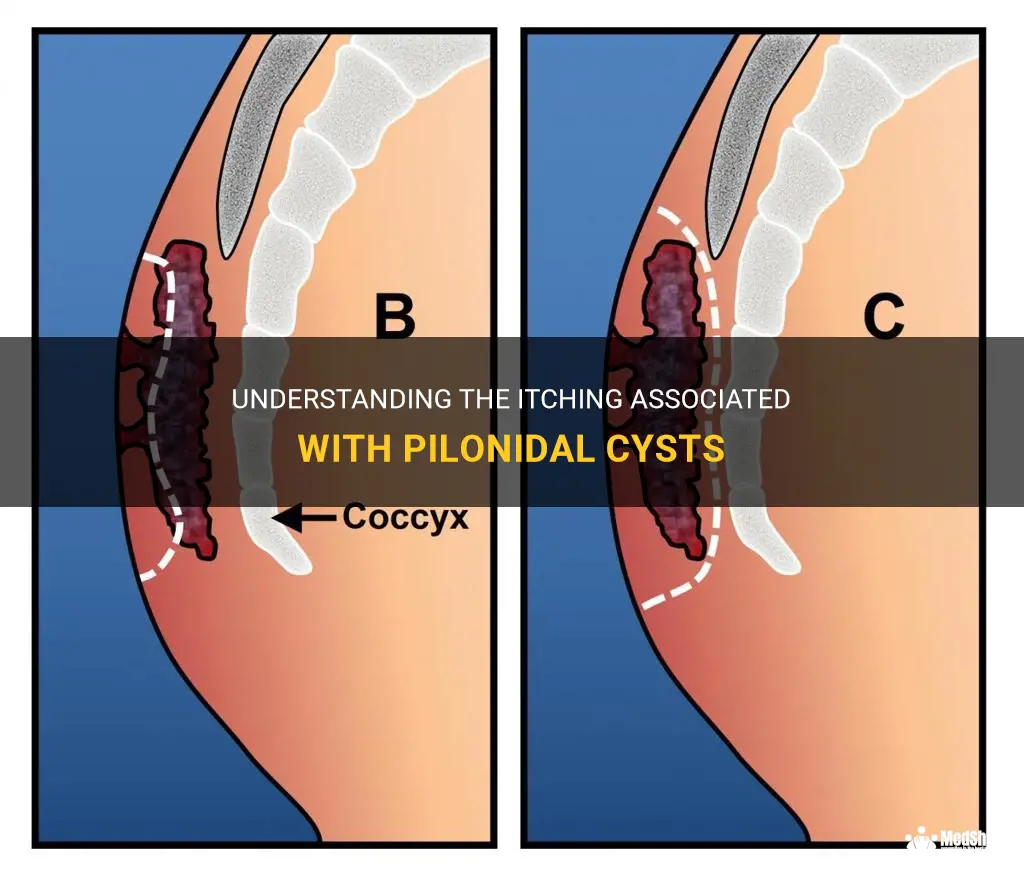
Imagine facing discomfort and itching in the most unexpected place—a pilonidal cyst. This unpleasant condition occurs at the base of your tailbone and can lead to painful abscesses and cysts. While the discomfort alone is enough to make you cringe, the persistent itching adds insult to injury. In this article, we will explore why pilonidal cysts itch and what you can do to find relief from this aggravating symptom.
| Characteristics | Values |
|---|---|
| Itching | Yes |
| Pain | Yes |
| Redness | Yes |
| Swelling | Yes |
| Discharge | Yes |
| Odor | Yes |
| Hair growth | Yes |
| Recurrence | Yes |
| Abscess | Yes |
| Pus | Yes |
What You'll Learn
- What are the common symptoms of a pilonidal cyst?
- Can a pilonidal cyst cause intense itching?
- How can I relieve the itching associated with a pilonidal cyst?
- Are there any over-the-counter creams or ointments that can help with the itching?
- When should I see a doctor for a pilonidal cyst, particularly if the itching becomes severe?

What are the common symptoms of a pilonidal cyst?
Pilonidal cysts are a type of cyst that occur in the sacrococcygeal area, which is the region at the very bottom of the spine. These cysts can cause a great deal of discomfort and can be quite painful if left untreated. Understanding the symptoms of a pilonidal cyst can help identify the condition early and seek appropriate treatment.
- Pain in the lower back: One of the most common symptoms of a pilonidal cyst is pain in the lower back. This pain may be mild at first and can gradually worsen over time. The pain is often described as a dull, aching sensation that is localized to the sacrococcygeal area.
- Redness and swelling: Another common symptom is redness and swelling around the cyst. The area may appear inflamed and tender to the touch. The skin may also feel warm to touch due to the inflammation caused by the cyst.
- Discharge of pus or blood: In some cases, a pilonidal cyst may become infected, leading to the discharge of pus or blood. This discharge is often accompanied by a foul odor and can be quite distressing. The discharge may also stain undergarments or clothing.
- Formation of an abscess: As the infection progresses, an abscess may form. An abscess is a collection of pus and dead tissue that forms as a result of the infection. The abscess can cause severe pain and may require medical intervention to drain the pus and provide relief.
- Formation of a sinus tract: In some cases, a pilonidal cyst may form a sinus tract, which is a small tunnel that connects the cyst to the surface of the skin. This can create a small hole or pit in the skin, which may constantly ooze fluid. The sinus tract can become infected, leading to recurrent abscesses.
It is important to note that not all pilonidal cysts cause symptoms. Some individuals may have an asymptomatic cyst that is only discovered incidentally during a physical examination. However, if symptoms do occur, it is essential to seek medical attention for proper evaluation and treatment.
In conclusion, the common symptoms of a pilonidal cyst include pain in the lower back, redness and swelling around the cyst, discharge of pus or blood, formation of an abscess, and the formation of a sinus tract. Recognizing these symptoms can help in early diagnosis and management of the condition. If you experience any of these symptoms, it is recommended to consult a healthcare professional for further evaluation and guidance.
Understanding the Purpose and Function of the Hole Above the Anus
You may want to see also

Can a pilonidal cyst cause intense itching?
Pilonidal cysts are a common condition that can cause discomfort and pain. One symptom that some individuals experience with pilonidal cysts is intense itching. This itching can be persistent and bothersome, leading individuals to seek relief.
Pilonidal cysts are cysts that form in the crease between the buttocks, near the tailbone. They occur when hair follicles become blocked and infected. The exact cause of pilonidal cysts is unknown, but factors such as prolonged sitting, excess hair, and tight clothing can contribute to their formation.
The intense itching that occurs with pilonidal cysts is likely due to inflammation and irritation of the surrounding skin. When the cyst becomes infected, it can cause redness, swelling, and tenderness. This inflammation can trigger an itching sensation, causing individuals to feel the need to scratch the affected area.
However, scratching the pilonidal cyst can worsen the symptoms and lead to further complications. Scratching can introduce bacteria from the hands into the open wound, increasing the risk of infection. It can also irritate the skin and delay the healing process.
To alleviate the intense itching associated with pilonidal cysts, individuals can try the following remedies:
- Keep the area clean and dry: Proper hygiene is essential in preventing further irritation and infection. Individuals should wash the area with mild soap and water, being gentle and avoiding excessive rubbing.
- Apply a warm compress: Placing a warm compress or soaking in a warm bath can help reduce inflammation and soothe the itching sensation.
- Use over-the-counter creams or ointments: Topical creams or ointments containing hydrocortisone can provide temporary relief from itching. However, it is important to follow the instructions and consult a healthcare professional before using any medication.
- Avoid tight clothing: Wearing loose-fitting clothing can help reduce friction and irritation in the affected area.
If the itching persists or becomes unbearable, it is essential to consult a healthcare professional. They can evaluate the pilonidal cyst and provide appropriate treatment options, including drainage or surgical removal if necessary.
In conclusion, pilonidal cysts can cause intense itching due to inflammation and irritation of the surrounding skin. Scratching the cyst can worsen symptoms and lead to complications. Proper hygiene, warm compresses, over-the-counter creams, avoiding tight clothing, and seeking medical advice when needed can help alleviate itching and promote healing.
Why Does the Top of My Bum Crack Split: Understanding the Causes and Solutions
You may want to see also

How can I relieve the itching associated with a pilonidal cyst?
Pilonidal cysts are a common condition that can cause itching and discomfort in the lower back and buttocks area. These cysts occur when hair follicles become infected and form a small pocket of pus. While it is important to see a healthcare professional for proper diagnosis and treatment, there are some steps you can take to help relieve the itching associated with a pilonidal cyst.
- Keep the area clean and dry: It is important to keep the area around the pilonidal cyst clean and dry to prevent further irritation and infection. Use a mild soap and warm water to gently clean the area and pat it dry with a clean towel. Avoid using harsh soaps or scrubbing the area, as this can exacerbate the itching.
- Apply a warm compress: A warm compress can help soothe the itching and reduce inflammation. Start by soaking a clean washcloth in warm water, then wring out the excess moisture. Apply the warm compress to the affected area for 10-15 minutes several times a day.
- Use over-the-counter anti-itch creams: Over-the-counter anti-itch creams containing ingredients like hydrocortisone or pramoxine can provide temporary relief from itching. Apply a small amount of cream to the affected area and follow the instructions on the packaging. However, it is important to note that these creams only provide temporary relief and should not be used for an extended period of time without consulting a healthcare professional.
- Avoid scratching: Although it can be tempting, scratching the pilonidal cyst can worsen the itching and increase the risk of infection. Try to resist the urge to scratch the area and distract yourself with other activities. If necessary, trim your fingernails short to reduce the risk of breaking the skin while scratching.
- Wear loose-fitting clothing: Tight clothing can rub against the pilonidal cyst and exacerbate the itching. Opt for loose-fitting clothing made from breathable fabrics like cotton to promote airflow and reduce friction. Avoid wearing tight jeans or underwear that can trap moisture and heat, as this can create an ideal environment for bacterial growth.
- Take oral antihistamines: In some cases, oral antihistamines may be recommended to relieve itching associated with a pilonidal cyst. These medications can help reduce the body's histamine response, which can alleviate itching. However, it is important to consult a healthcare professional before starting any new medication to ensure it is safe and appropriate for you.
- Seek medical treatment: If home remedies and over-the-counter treatments do not provide relief from the itching or if the cyst becomes increasingly painful, red, or swollen, it is important to seek medical attention. A healthcare professional can perform procedures such as draining the cyst or prescribing antibiotics to manage the infection and provide relief from the itching.
It is important to remember that these tips are not a substitute for medical advice. If you are experiencing itching or discomfort associated with a pilonidal cyst, it is best to consult a healthcare professional for proper evaluation and treatment. They can provide personalized recommendations based on your specific situation and help alleviate your symptoms effectively and safely.
Understanding the Anatomy: The Reasons for Having Two Holes in Your Bum
You may want to see also

Are there any over-the-counter creams or ointments that can help with the itching?
If you've ever experienced itching, you know how uncomfortable and frustrating it can be. Whether it's due to a bug bite, a skin rash, or an allergic reaction, the urge to scratch can be almost unbearable. Thankfully, there are many over-the-counter creams and ointments available that can help provide relief from itching.
When it comes to choosing an over-the-counter cream or ointment for itching, it's important to consider the underlying cause of your itching. Different creams and ointments are designed to target specific issues, so it's important to choose one that is appropriate for your particular situation.
One popular option for relieving itching is hydrocortisone cream. Hydrocortisone is a mild steroid that can reduce inflammation and itchiness. It's commonly used to treat conditions such as eczema, psoriasis, and insect bites. Hydrocortisone cream can be applied directly to the affected area and is usually effective in providing quick relief. However, it's important to remember that prolonged use or excessive application of hydrocortisone cream can have negative side effects, such as thinning of the skin.
Another option for relieving itching is calamine lotion. Calamine lotion contains zinc oxide, which has a soothing and cooling effect on the skin. It can be particularly effective in relieving itching caused by conditions such as poison ivy, oak, or sumac. Calamine lotion can be applied directly to the affected area and provides a protective barrier that helps prevent further irritation.
If you're looking for a more natural remedy, there are also several herbal creams and ointments that can help relieve itching. For example, creams containing chamomile extract or aloe vera can provide soothing relief for irritated or itchy skin. These ingredients have anti-inflammatory properties and can help calm redness and irritation.
It's important to note that while over-the-counter creams and ointments can provide temporary relief from itching, they are not a long-term solution. If you're experiencing persistent or severe itching, it's important to consult a healthcare professional for a proper diagnosis and treatment plan.
In addition to using creams and ointments, there are several other steps you can take to help reduce itching. First, try to avoid scratching the affected area, as this can further irritate the skin and prolong the itch. Instead, try applying a cold compress or taking an oatmeal bath to soothe the itch. It's also important to keep the affected area clean and dry, as moisture can worsen itching. Finally, try to identify and avoid any triggers that may be causing your itching, such as certain fabrics, soaps, or detergents.
In conclusion, there are several over-the-counter creams and ointments that can help provide relief from itching. Whether you choose a hydrocortisone cream, calamine lotion, or an herbal remedy, it's important to choose a product that is appropriate for your particular situation. Remember, these creams and ointments provide temporary relief and should not be used as a long-term solution. If your itching persists or worsens, it's important to consult a healthcare professional for further evaluation and treatment.
Understanding the Process of Lancing a Cyst: What You Need to Know
You may want to see also

When should I see a doctor for a pilonidal cyst, particularly if the itching becomes severe?
Pilonidal cysts are uncomfortable, often painful, cysts that form at the base of the tailbone. They can cause a variety of symptoms, including itching. However, knowing when to see a doctor for a pilonidal cyst, particularly if the itching becomes severe, can help ensure proper treatment and relief from the discomfort.
Typically, when a pilonidal cyst first develops, it may cause mild to moderate itching. This itching is usually accompanied by redness, swelling, and tenderness in the area. It is not uncommon for individuals to try to relieve the itching on their own by scratching or applying topical creams. However, severe itching that persists or worsens over time is a sign that medical attention is necessary.
One of the reasons severe itching should be evaluated by a doctor is to rule out other causes. While pilonidal cysts are the most common cause of itching in the tailbone area, there are other conditions that can cause similar symptoms. For example, fungal infections, dermatitis, and even certain types of skin cancer can present with itching in the same area. Therefore, it is important to have a healthcare professional evaluate the severity and persistence of the itching to ensure the correct diagnosis and appropriate treatment.
Additionally, when the itching becomes severe, it may indicate an underlying infection in the cyst. Pilonidal cysts have the potential to become infected, leading to symptoms such as increased pain, swelling, and drainage of pus or blood. Severe itching, especially when accompanied by these other symptoms, should prompt a visit to the doctor. Infection in a pilonidal cyst can be serious and may require medical intervention, such as antibiotics or even surgical drainage.
Furthermore, severe itching can significantly impact an individual's quality of life. The constant urge to scratch can cause significant discomfort and disrupt daily activities. It can also lead to sleep disturbances and can affect mental well-being. Seeking medical attention for severe itching can help alleviate these symptoms and provide relief.
When visiting a doctor for severe itching associated with a pilonidal cyst, it is important to provide a thorough medical history and describe the progression of symptoms. This will help the doctor make an accurate diagnosis and develop an appropriate treatment plan. Depending on the severity and duration of the itching, the doctor may recommend conservative measures such as warm compresses or topical creams to relieve the itching. In cases of infection or recurrent cysts, surgical intervention may be necessary.
In conclusion, severe itching associated with a pilonidal cyst should prompt a visit to a healthcare professional. The itching may be a sign of infection or another underlying condition that requires medical intervention. Seeking timely medical attention will not only provide relief from discomfort but also ensure proper diagnosis and treatment. Remember, it's always better to be safe than sorry when it comes to your health.
Understanding the Causes and Solutions for an Itchy Tailbone
You may want to see also



